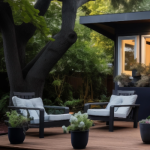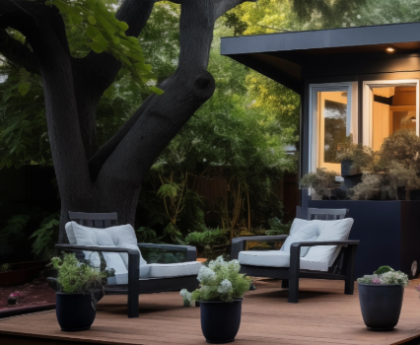In August, Atlanta Mayor Andre Dickens signed an executive order authorizing $4 million to build a community for unhoused Atlantans with 40 ADUs created out of shipping containers in a parking lot at 184 Forsyth St.
Credit: Jeff Herr
Credit: Jeff Herr
“ADUs are a great solution for affordable housing,” said Wanona Satcher of Makhers Studio in East Point, where her factory turns reclaimed shipping containers into affordable homes. She has created ADU homes for veterans in North Carolina and has several projects coming up in Atlanta’s Old Fourth Ward.
“The myth is that you can’t build affordable housing in communities like Buckhead or Old Fourth Ward. And we’re here to tell you that you can if you change your strategy,” Satcher said.
Because she is using modular units, they tend to be less expensive than small homes built with conventional construction methods. They also have a smaller footprint — around 320 square feet on average for her homes. The average cost for one of her one-bedroom, one-bath ADUs is $65,000.
Anthony Pope of Pittsburgh Yards’ Atelier 7 Design + Assembly said that shipping container homes are a good model because they go up much faster than traditional homes. Pope has been building many of his ADUs as second mountain homes.
Credit: Lauren Hubbard
Credit: Lauren Hubbard
He has occasionally found some resistance to the corrugated metal facade of shipping containers in some neighborhoods. His preference is to give his ADUs a mid-century modern look, though his customers often prefer farmhouse style.
“Everything we’ve been doing recently has some form of wood cladding to it, some board and batten or something as a contrasting texture,” he said. His structures are generally priced at $109,000 for a one-box structure and at $150,000 for a larger, two-box structure. The sizes range from 160 square feet up to 3,000 square feet.
Whether they are creating backyard structures clad in farmhouse style or using shipping containers to bring an industrial look to urban spaces, Atlanta ADU business owners agree that they are a sustainable, stylish and affordable option.
“Because they’re microspaces, the energy efficiency is pretty easy to attain,” said Satcher.
Credit: Lauren Hubbard
Credit: Lauren Hubbard
Intergenerational approaches to housing are a big driver in the rise of ADUs, Satcher said, with parents building one in the backyard for family members, later giving their own larger home to their adult children when it comes time to raise a family and then moving into the ADU to “age in place.”
Heather Shuster of Alair Homes in Decatur builds ADUs from the ground up instead of from shipping containers. The costs can range dramatically.
“I seldom see these structures for less than $100,000 or $150,000,” she said. “And they can go well into the three or four hundreds, depending on all the features and function and size that the homeowner wants.”
Regardless, ADUs can be an answer to the need for additional space on a small intown lot. “Intown, homes generally just don’t have tons and tons of space. And they also often don’t have a garage. So the vast majority, we’re doing are a combination of garage with the accessory dwelling space, above,” she said.
Credit: Jeff Herr
Credit: Jeff Herr
Rules for ADUs vary from neighborhood to neighborhood, but Shuster noted that many intown neighborhoods will not allow an ADU to have a fully functional kitchen with a stove and oven because of single-family zoning regulations.
And if you are living in a historic neighborhood like Grant Park or Druid Hills, you may need to submit the exterior design for historic approval. So in cases like those, building a modern-style ADU might not fly. Homeowners also need to be realistic about the amount of time it takes to complete an ADU, including the planning and permit process. Shuster estimates it at 12 to 18 months.
ADUs have unique interior design requirements. Many of them are composed of a single, open space so clever ways to create and hide storage are a necessity.
There are also design advantages to ADUs, said Pope, who combines shipping containers in a number of Lego-like configurations and said that their strong steel shells open up some design opportunities when it comes to adding large windows. They are 300 times stronger than a wood house, he said, meaning you can install a 9-foot sheet of glass “that really connects you to the outdoors.”
Credit: Handout
Credit: Handout
He gets creative when designing his ADUs, adding counters that pull out to become a place to eat, pull-down beds and areas that make up for their smaller size by opening to the outside.
“It’s a special tribe,” said Pope of his typical customer. “They’re looking for something a little bit different, something edgy. It does have capabilities of doing some things you just can’t do in wood.”
Felicia Feaster is a longtime lifestyle and design editor who spent 11 years covering gardening, interior design, trends and wellness for HGTV.com. Felicia is a contributor to MarthaStewart.com and has been interviewed as a design expert by The New York Times, Forbes and the Associated Press.




